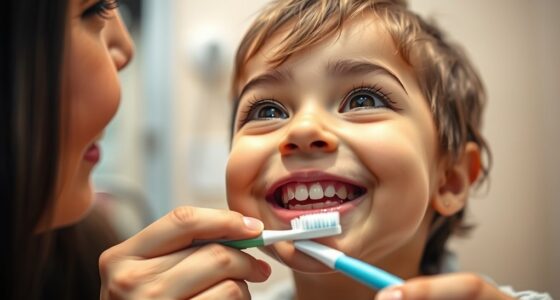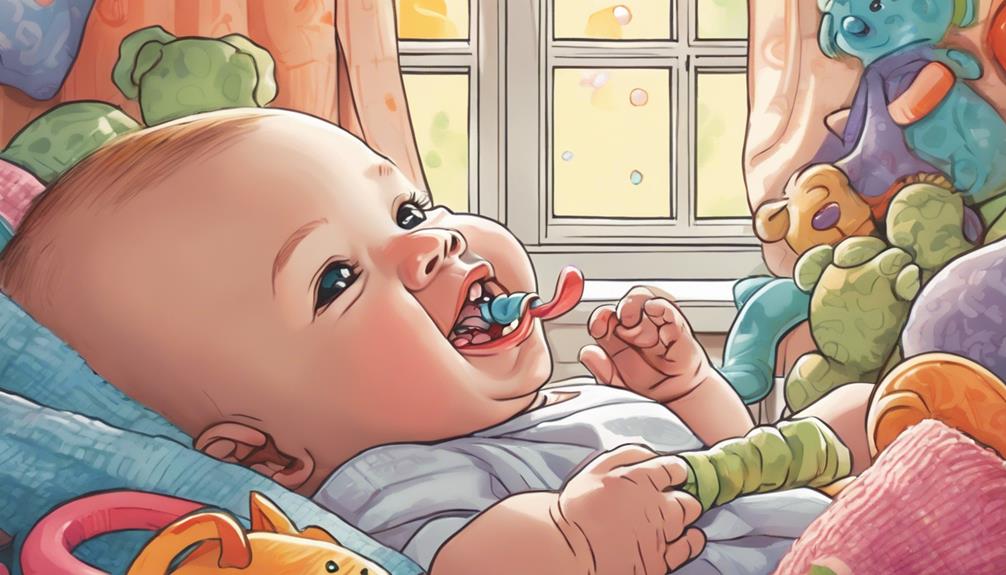By the time your baby is three years old, they'll usually have a full set of 20 primary teeth. Teething starts around six months, with the lower central incisors coming in first, typically between 6 to 10 months. Then, the upper central incisors emerge between 8 to 12 months, followed by the upper lateral and lower lateral incisors. Most kids have their first molars by 18 months. Each child's teething timeline can vary, so don't worry if yours is a bit different. If you're curious about how to support your baby through this process, you might find what comes next helpful.
Key Takeaways
- Babies typically start teething around 6 months, with the first teeth usually erupting between 6 to 12 months.
- The first teeth to appear are lower central incisors, followed by upper central incisors.
- By age 3, most children have a complete set of 20 primary teeth.
- The order of eruption continues with lateral incisors, molars, and canines in later months.
Teething Timeline Overview
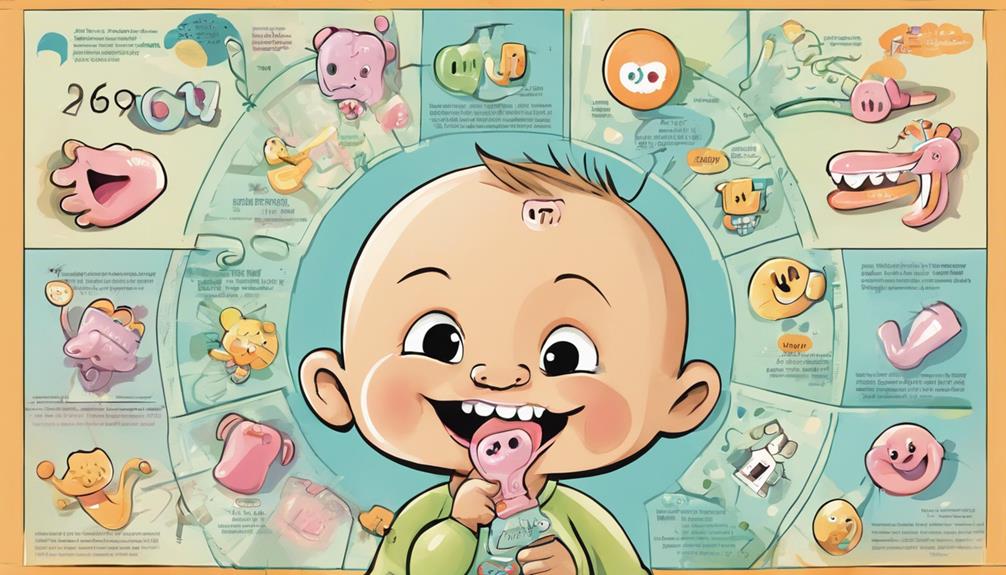
Understanding your baby's teething timeline can help you anticipate when those first teeth will make their appearance. Typically, babies begin teething around 6 months, with the first tooth usually erupting between 6 to 12 months. The lower central incisors are the first to come in, generally appearing between 6 to 10 months. This is the starting point of your baby's tooth eruption journey, and it's crucial to keep track of this progression.
By age 3, most children will have a complete set of 20 primary teeth, which includes 10 in the upper jaw and 10 in the lower jaw. The American Academy of Pediatrics emphasizes the importance of understanding the teething timeline, as it can vary widely among infants. Some babies may start teething earlier or later than the average range, so don't worry if your child's timeline doesn't match the baby teeth chart exactly. “Parents should be aware that the order in which baby teeth come in can also vary. Typically, the lower central incisors are the first to appear around 6-10 months, followed by the upper central incisors. Then, the lateral incisors, first molars, canines, and finally second molars will come in. If you have concerns about when do baby teeth come in for your child, it’s always best to consult with a pediatric dentist for guidance.
Watching for signs of teething can help you provide comfort during this phase. Familiarizing yourself with the teething timeline will prepare you for the changes your baby will experience as those little teeth start to make their debut.
Order of Tooth Eruption
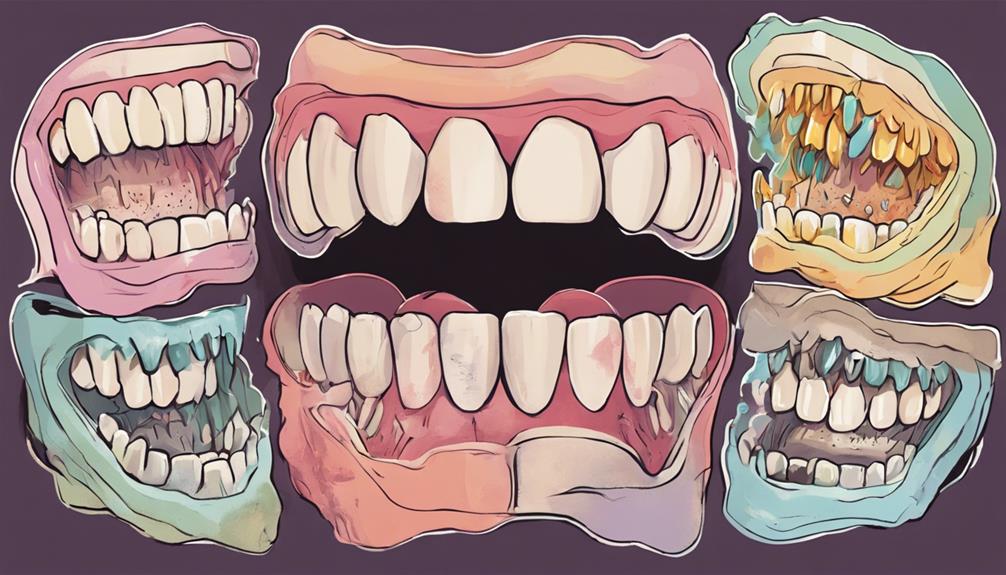
When your baby starts getting teeth, you'll notice a specific order in their eruption.
Typically, the lower central incisors come in first, followed by the upper ones, and then the molars.
Understanding this timeline can help you track your child's dental development and identify any variations that might occur.
Typical Eruption Timeline
The typical eruption timeline for your baby's teeth starts with the lower central incisors, usually appearing between 6 to 10 months of age. After those first teeth, you can expect the following:
- Upper central incisors: These typically emerge between 8 to 12 months.
- Upper lateral incisors: These come in between 9 to 13 months, while the lower lateral incisors appear from 10 to 16 months.
- First molars: The upper first molars usually erupt between 13 to 19 months, and the lower first molars come in from 14 to 18 months.
As you monitor this typical eruption timeline, remember that every baby is different. While these are the average months for each set of teeth, some babies may get their baby teeth sooner or later than these ranges.
First Teeth to Erupt
Your baby's first teeth typically erupt in a specific order, starting with the lower central incisors around 6 to 10 months of age.
After the lower central incisors, you'll notice the upper central incisors making their appearance between 8 to 12 months. This is often an exciting time for you, but it can also bring about some teething symptoms, like irritability and drooling.
Next up are the lateral incisors. The upper lateral incisors usually erupt between 9 to 13 months, while the lower lateral incisors follow, coming in between 10 to 16 months.
After those, the first molars come into play. The upper first molars typically emerge between 13 to 19 months, and the lower first molars show up from 14 to 18 months.
Variations in Eruption Patterns
Variations in tooth eruption patterns can occur among infants, with some babies experiencing differences in timing and order compared to the typical sequence.
While many babies follow a predictable teething chart, others may surprise you. It's important to understand that each child's development is unique and can show signs of discomfort at different stages.
Here are three common variations you might notice:
- Delayed Eruption: Some infants may not get their first baby tooth until after 12 months.
- Order Changes: While the lower central incisors usually erupt first, sometimes the upper incisors come in earlier.
- Missing Teeth: In rare cases, some babies may be born without specific deciduous teeth, impacting their full set.
As you observe your baby's gums, remember that variations are normal. Keep an eye on their teeth to come, and consult your pediatrician if you have concerns.
Early dental visits can help guarantee your child's oral health remains on track, even if their eruption pattern differs from the norm.
Signs of Teething
Signs of teething can include increased drooling, gum swelling, and a strong desire to chew on objects or fingers for relief.
When your baby is teething, you might notice that the gums around emerging teeth become tender and swollen. This discomfort often leads to irritability and fretfulness, making your little one more difficult to soothe.
You may also observe sleep disturbances as your baby struggles to fall asleep or stay asleep due to teething discomfort. In some cases, a mild fever, generally less than 100.4°F (38°C), can accompany the teething process. However, if you notice a high fever, it's best to consult with a pediatrician, as this may indicate an illness rather than a normal teething symptom.
As you pay attention to these signs of teething, you'll gain a better understanding of what your baby is experiencing.
Recognizing these indicators can help you provide the comfort they need during this challenging phase. Remember, every baby is different, but being aware of these common signs will prepare you for when the first tooth finally arrives.
Soothing Teething Discomfort

To soothe teething discomfort, try using cold teething rings or frozen washcloths, which can numb sore gums effectively. These methods provide much-needed relief for your child during this challenging time.
If you're looking for additional ways to help alleviate teething discomfort, consider these options:
- Massage the gums: Gently rub your child's gums with clean fingers. This can help ease the discomfort and irritability caused by erupting teeth.
- Use over-the-counter pain relievers: If your child experiences severe teething pain, consult your pediatrician about safe, appropriate pain relief options.
- Avoid certain products: Steer clear of teething gels containing benzocaine, as they pose safety concerns for infants.
Importance of Oral Hygiene

As soon as your baby's first tooth appears, it's essential to start their oral hygiene routine.
Brushing their teeth twice a day helps establish healthy habits and sets the stage for a lifetime of good dental care.
Early dental visits are also key to monitoring their development and preventing issues down the road.
Early Dental Care
Establishing a solid oral hygiene routine early on is essential for your baby's dental health. You should start as soon as those baby teeth appear, usually around 6 months.
Here are three important steps to follow:
- Brush twice daily: Use a soft-bristled toothbrush and a smear of fluoride toothpaste to clean your baby's teeth twice a day. This helps prevent tooth decay and promotes healthy gums.
- Schedule the first dentist visit: Aim for your baby's first dental check-up by their first birthday or when the first tooth appears. This allows you to monitor dental development and receive personalized oral hygiene advice.
- Avoid sleeping with a bottle: Never put your baby to bed with a bottle, as this can lead to tooth decay known as 'bottle rot.'
Daily Brushing Routine
Brushing your baby's teeth daily is vital for preventing cavities and fostering healthy dental habits from an early age. As soon as your baby's first tooth erupts, usually around 6 months, start brushing twice a day using a soft-bristled toothbrush and a smear of fluoride toothpaste. This practice helps to establish good oral hygiene and prevent tooth decay.
Make brushing a routine by doing it after breakfast and before bedtime. This consistency promotes healthy dental habits that will carry into their later years. Avoid putting your baby to bed with a bottle or dipping pacifiers in sugary substances, as these practices can lead to tooth decay.
For children over 3, use a pea-sized amount of fluoride toothpaste to provide effective protection against cavities while guaranteeing safe ingestion.
It's vital to monitor brushing and assist your child until they're about 7 or 8 years old. This oversight guarantees they're using proper technique and thoroughly cleaning their baby teeth.
Safe Teething Products

When choosing safe teething products for your baby, look for options like BPA-free teething rings and frozen washcloths that soothe sore gums without posing choking risks. It's crucial to prioritize safety while providing your baby with soothing relief.
Consider the following tips:
- Opt for teething rings made from BPA-free materials: These are safe for your baby to chew on and help alleviate discomfort.
- Choose silicone teething toys: Durable and easy to clean, silicone toys can also be refrigerated for added cooling relief. Make sure they've no small parts that could pose a choking hazard.
- Avoid teething tablets with harmful ingredients: Steer clear of products containing belladonna or benzocaine, as these can have serious side effects.
Always supervise babies while they use teething products. Keeping an eye on them guarantees they're safe and helps prevent any accidents.
First Dental Appointment Timing
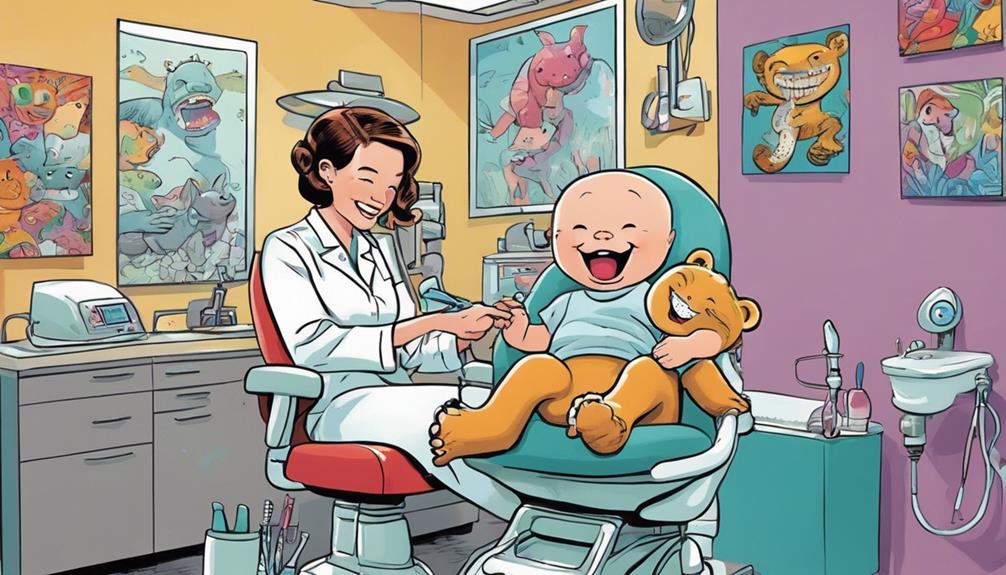
Scheduling your baby's first dental appointment after their first tooth erupts is key, ideally by their first birthday. This early visit allows you to establish a dental home, a place where your child can receive consistent oral care guidance.
Pediatric dentists emphasize the importance of this timing to monitor your child's dental development and provide essential dental health checks. Regular well-child visits often include discussions about oral care, but a dedicated dental appointment guarantees a thorough examination of your child's teeth and gums.
During this visit, the dentist won't only check for any potential issues but also offer advice on how to care for those first teeth. This proactive approach can help prevent future dental issues.
If a pediatric dentist isn't available, don't hesitate to consult a general dentist experienced with infants and young children. Remember, the goal is to create a positive experience around dental visits, which can set the foundation for a lifetime of good oral health.
Cultural Perspectives on Teething

Understanding how different cultures view teething can provide valuable insights into your own parenting choices and practices as your baby grows. Many cultures have unique beliefs and methods to address teething pain, which can enrich your approach to supporting your child.
Here are three key aspects to evaluate:
- Traditional Practices: Some cultures use specific foods or items to soothe teething pain, reflecting their cultural heritage. For instance, certain fruits or cold items may be offered to infants.
- Herbal Remedies: In various communities, parents turn to herbal remedies to alleviate discomfort. These natural solutions can be a comforting option, rooted in age-old traditions.
- Teething Rituals: Teething is often celebrated with rituals that signify important development milestones. These practices not only provide comfort but also foster a sense of community and shared experience among families.
Frequently Asked Questions
What Teeth Should a 1 Year Old Have?
By age 1, your child typically has 2 to 8 teeth, often starting with the lower central incisors. Don't worry if they don't have any yet; timing can vary widely among infants. The American Dental Association recommends that children see a dentist within six months of getting their first tooth, or by their first birthday. This helps ensure that their teeth and gums are healthy and allows the dentist to monitor their baby teeth development timeline. While it can be concerning if your child is slow to start teething, it’s important to remember that every child is different and will develop at their own pace.
What Are the Worst Teeth for Teething?
Imagine a dragon's roar—those are the molars and canines during teething! You'll notice your little one's discomfort peaks with these larger teeth, causing irritability, drooling, and sleepless nights as they emerge.
What Is the Order of Teeth Coming in for a Baby?
When your baby starts teething, you'll notice the lower central incisors appear first, followed by the upper central incisors. The process continues with lateral incisors, molars, and canines, usually completing by age three.
Which Teeth Are Most Difficult for Babies?
The most difficult teeth for babies are typically the upper lateral incisors and first molars. Their size and position can cause significant discomfort as your baby's gums struggle to break through the tissue.
Conclusion
In the journey of parenthood, watching your baby's teeth come in is like witnessing the first bloom of spring—exciting and full of promise.
Remember, every child is unique, and their teething timeline may vary.
By staying informed and prepared, you can soothe their discomfort and foster good oral hygiene habits early on.
Don't hesitate to consult your pediatrician for guidance and set up that first dental appointment to guarantee your little one's smile shines bright!



